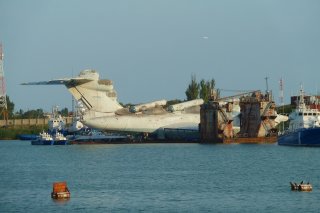RIP, Sea Skimmer: The Last of the Soviet Ekranoplans Will Soon Retire
You remember the Soviet Union’s massive sea-skimmer? It is set to retire soon—for good.
Ground Effect Vehicles, also known as ekranoplans, take advantage of a strange aerial phenomenon in which at extremely low altitudes: at roughly ten to twenty feet an airplane’s wings ‘ride’ on a cushion of air that helps keep the craft airborne.
Because of this strange phenomenon, an ekranoplan weighing much more than a normal-sized plane can take off and fly, despite having very stubby and compact wings. These are the principles that the Soviet Union’s single Lun-class ekranoplan took advantage of. Meet the Lun-class.
Lun-class
The Lun-class was meant to be a very fast and very heavily armed boat/plane hybrid that could do it all—from maritime patrol, to reconnaissance, and troop transport. One of its most important missions would have been anti-surface warfare.
The Lun was massive—four turbojet engines on each side of the Lun allowed it to reach speeds in excess of what any ship would have been able to reach. To compliment the Lun’s blazing speeds, it was also equipped with six anti-ship missiles housed in silos on the top of the ekranoplans’s fuselage—one of aspects of the Lun that was particularly dangerous.
Because of the Lun-class’ very low maximum altitude, it could in theory ply the waters near the Soviet coast undetected by the United States or its allies. Furthermore, it could launch its sea-skimming missiles literally under an enemy’s radar. The Lun-class’ Moskit missiles are thought to have a range of about sixty miles, or around ninety-five kilometers, a distance that they could close in the blink of an eye thanks to their Mach 3 speed.
Large and impressive as the Lun-class is, it was dwarfed by an even larger Soviet ekranoplan, dubbed by American intelligence as the Caspian Sea Monster.
Intelligence Kerfuffle
The largest ground effect vehicle ever built caused quite a stir when it was spotted by the Central Intelligence Agency in the late 1960s. Satellites over the Caspian Sea photographed the prototype craft undergoing taxi and take-off test runs near the shore, leading to several imaginative guesses as to what exactly the massive plane-like craft was designed for. Because it was photographed on the Caspian Sea, the massive airframe was dubbed the Caspian Sea Monster.
Postscript
Though two Lun-class airframes were originally planned, Moscow only managed to build one, the second falling victim to the collapse of the Soviet Union and a lack of available funding. Though it was since mothballed by the Russian military, it is making one last journey (likely being towed rather than flying) before final retirement and will serve the rest of its years as a museum piece. An interesting end to a one-of-a-kind design.
Caleb Larson holds a Master of Public Policy degree from the Willy Brandt School of Public Policy. He lives in Berlin and writes on U.S. and Russian foreign and defense policy, German politics, and culture.
Image: Reuters

